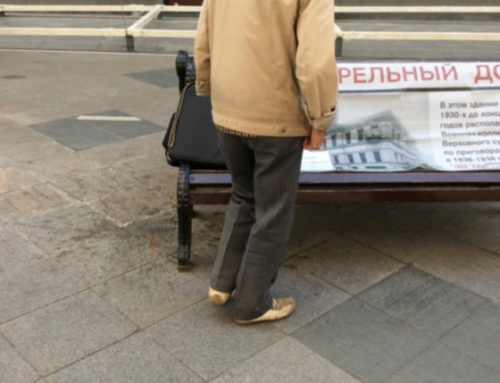
Former student activist examining his personal archive, including photocopies of his court documents, his statement of amnesty from Reform-era president B.J. Habibie, and hand-written postcards and letters. (Doreen Lee, 2014)
Living under the surveillance of the New Order regime, Indonesia’s military dictatorship that lasted from 1966 to 1998, meant that activists had to be creative in order to carry out their acts of resistance. Very few demonstrations took place. The repression of street politics led to the cultivation of other forms of politics, in particular the politics of print material. The 1980s and 1990s were an intellectually productive time when activists focused on reading and translating forbidden books, debating critical leftist ideas in study clubs, and making their own propaganda. The techniques that they described often involved photocopying, pilfering, borrowing, and other assorted DIY methods. Many activists photocopied banned books at select copy shops. They were proud owners of the dissident writer Pramoedya’s banned works of fiction and nonfiction. Andi told me about making zines when he was a student activist in the 1990s. He recalled photocopying pages and then assembling the zines by hand with a stapler. At a café meeting in 2013, it didn’t take much prompting for three former student activists to remember the exact year they began using different technologies for their political work: from diskettes to email. Yudhi, the youngest activist in the group, was the most technologically forward. He already had access to email in 1993 because he was still formally enrolled as a student at a university that had computer labs. But he was also an expert user of the old mimeograph machine that belonged to the campus newspaper. He would “occupy” the machine to print out copies of activist propaganda. Another activist described the prosperous years of democratic transition as a time when he could source money and paper easily. If his organization needed funds for printing materials, they would rent a bus for a day and “collect” money from bystanders and passengers.
This essay is about how activists and the scholars who study them arrive at new valuations of activist labor, specifically the labor of making and reproducing papers. It suggests that the lived reality of dissent, in particular the daily performances and bodily techniques of making, distributing, and writing propaganda, remains an untapped resource for understanding activist memories about protest and resistance. Indonesian activists produced a lot of papers in their line of work, from pamphlets to fliers to prison letters, and I as an anthropologist studying their political movements collected a lot of them. Many of these papers are not unique. They are, like anything that can be photocopied, photographed, digitized, saved, burned, compressed, and copied again, not assigned original or authentic value. In the age of digitization, urban densification, and considering the growth industry of organizational experts who combat clutter (of which papers form their own category), how do we rethink the meaning and value of ethnographic materials that are not-yet-historical nor especially unique or informative? How can we trace the history of dissent through these materials? I shift our attention to the routine activist experience of technology to make visible the sociality and the infrastructure of dissident knowledge production. The labor of making and circulating dissident papers forged lasting and intimate memories about political life, visible in the ways that activists recalled the sensory aspects of such work, and particular times and persons. Such memories enliven ordinary artifacts and might help explain why certain paper forms remained salient to activism over a long period of time.
Take for instance the prototypical black-and-white format of the activist flier. In the last decade of Indonesia’s military dictatorship (1988-1998), student activists were persecuted by the state and jailed for possessing and handing out selebaran (fliers) that were critical of the regime. The selebaran (flier) is a hallmark feature of Indonesian activism and propaganda craftsmanship. It can be made and sourced in different ways – printed by hand on a mimeograph machine, photocopied in copy shops, or printed at a local printing press. It is small, no more than a hands’ span of thin newsprint, containing a combination of fine print and capital letters, announcing the cause of a demonstration and its time and location details. It functions as an invitation and a messaging system. Handed out by (mostly male) activists on the street a day before the planned demonstration, the selebaran announces the event-to-come and anticipates that the masses will gather in support. The outcomes are mixed; some might be drawn to watch or even participate, but on the whole the fliers get thrown away unread. These fliers continue to be used in some parts of Indonesia as part and parcel of social movement actions, even as large swathes of organizing have now migrated online. The flier’s content changes according to the times: in the era of military dictatorship there were demonstrations about militarism, nepotism, and labour violations; in the years of democratic transition the demonstrations turned to issues of state accountability, human rights, and citizenship. Selebaran may seem obsolete now, but they are an important part of activist history.
The uncertain value of mass produced papers is linked to their abundance and their ordinariness. Ann Stoler posits the idea of “archiving as dissensus” to address the things that exceed the normative shape and possibilities of the archive, whether because these objects are marginal or somehow misshapen. Dissensus is one way to collect but not discipline materials with unexplored origins, intentions, and lived experiences (Stoler 2018). When I first started asking activists about the role of photocopies in student movement activism, I heard a common refrain. Memories about the act of making propaganda came readily to the surface, but paper was not privileged or prioritized as the site of activist memories in the same way that the street demonstration was.
Activists were perplexed by my interest in their copying practices. One activist, Gugun, called it extremely trivial. It was perhaps a cute idea, in the way that Sianne Ngai describes “cute” as an aesthetic judgment about plastic, diminutive things that are consigned to a minor category (Ngai 2015). “Cute” is in many ways the opposite of the political-rational landscape of left-wing activism. This judgment by Gugun predated the era of internet political humour and memes, but it struck me that an experienced activist who had committed his fair share of time to making Marxist propaganda believed I was making something out of nothing – mengada-ada – by asking about the paper itself, without properly attending to the ideological content of dissent. Another activist, Rahman, was more forgiving of the question. Thinking about photocopies and fliers made him see the 1990s as monochrome “black and white,” whereas now they were living in “color.” The filmic metaphor, from black-and-white to technicolour, is actually a technologized shift that shows the evolution from labor-intensive and crude techniques of reproduction to more refined, costly, and perfect copies.
Two decades after the fall of the New Order, activist projects have begun to explore ideas about sustainability, digital literacy, and writing the movement’s own history. Current projects include inspiring and monumental work like building small human rights museums, independent presses, media platforms, activist bookstores and shared community and workspaces. Interest in these counterhegemonic projects may eventually lead to a renewed interest in the now-original artefacts of an earlier time of protest and resistance.
References
Ngai, Sianne. 2015. Our Aesthetic Categories: Zany, Cute, Interesting. Cambridge: Harvard University Press.
Stoler, Ann Laura. 2018. “On Archiving as Dissensus.” In “Palestine: Doing Things with Archives” special issue. Comparative Studies of South Asia, Africa and the Middle East 38 (1): 43-56.
Cite as
Lee, Doreen. 2019. “The Paper Trail of Dissent in New Order Indonesia.” In Tobias Kelly, ed., “The Intimacy of Dissent,” American Ethnologist website, April 15, 2019. http://americanethnologist.org/features/collections/the-intimacy-of-dissent/the-paper-trail-of-dissent-in-new-order-indonesia.
Doreen Lee is Associate Professor of Anthropology in the Department of Sociology and Anthropology at Northeastern University.




